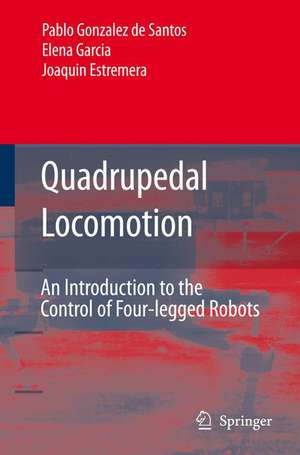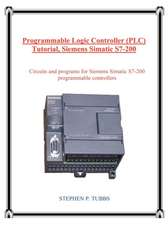Quadrupedal Locomotion: An Introduction to the Control of Four-legged Robots
Autor Pablo González de Santos, Elena Garcia, Joaquin Estremeraen Limba Engleză Hardback – 19 apr 2006
| Toate formatele și edițiile | Preț | Express |
|---|---|---|
| Paperback (1) | 943.88 lei 6-8 săpt. | |
| SPRINGER LONDON – 13 mar 2012 | 943.88 lei 6-8 săpt. | |
| Hardback (1) | 948.47 lei 6-8 săpt. | |
| SPRINGER LONDON – 19 apr 2006 | 948.47 lei 6-8 săpt. |
Preț: 948.47 lei
Preț vechi: 1156.67 lei
-18% Nou
Puncte Express: 1423
Preț estimativ în valută:
181.51€ • 188.80$ • 149.85£
181.51€ • 188.80$ • 149.85£
Carte tipărită la comandă
Livrare economică 14-28 aprilie
Preluare comenzi: 021 569.72.76
Specificații
ISBN-13: 9781846283062
ISBN-10: 184628306X
Pagini: 268
Ilustrații: XIV, 268 p.
Dimensiuni: 155 x 235 x 21 mm
Greutate: 0.53 kg
Ediția:2006
Editura: SPRINGER LONDON
Colecția Springer
Locul publicării:London, United Kingdom
ISBN-10: 184628306X
Pagini: 268
Ilustrații: XIV, 268 p.
Dimensiuni: 155 x 235 x 21 mm
Greutate: 0.53 kg
Ediția:2006
Editura: SPRINGER LONDON
Colecția Springer
Locul publicării:London, United Kingdom
Public țintă
ResearchDescriere
Legged robots have proven to be a promising locomotion system, capable of performing tasks that conventional vehicles cannot perform. Even more exc- ing is the fact that this is a rapidly developing ?eld of study for researchers from a variety of disciplines. Over the past three decades, legged locomotion technology has been developed all over the world, resulting in the invention of many important new machines and methods. However, only a few books have been published on the subject of multi-legged robots. The main objective of this book was to explore some of the major issues that the authors have been analyzing over the past ten years. A second objective was to write a book that only encompasses quadruped locomotion, the ?rst specialized book on this topic. The book is divided into two parts: Walking Measurements and Algorithms, and Control Techniques. The ?rst part is devoted exclusively to the theoretical aspects of quadrupeds. The ?rst chapter is an introduction to the historic development of multi-legged robots, highlighting their advantages and disadvantages, main features, and potential and actual applications, as well as discussing basic concepts and the trade-o? between quadrupeds and hexapods. Finally, new and traditional stability measurements and gait g- eration algorithms for quadrupeds are explained. The second part of the book deals with general design and control algorithms (kinematics and dynamics) and techniques aimed at improving the main features of robots, such as speed and ground detection, interfaces,etc.
Cuprins
Part I Walking Measurements and AlgorithmsWalking RobotsStability in Walking RobotsGeneration of Periodic GaitsGeneration on Non-periodic GaitsNew Approaches to Stability Part II Control TechniquesKinematics and DynamicsImproving Leg Speed by Soft Computing TechniquesVirtual Sensors for Walking RobotsHuman-Machine InteractionThe SIL04 Walking RobotSimulation Software for Walking Robots
Recenzii
From the reviews:
"This book is devoted to the imitation of walking by the development of machines with legs, also widely known as legged robots; in other words, mechanical systems that move themselves by using devices that resemble legs. … The book is of high level and it can be of great importance for researchers to expand on legged robot techniques."
(George S. Stavrakakis, Zentralblatt MATH, Vol. 1112 (8), 2007)
"This book is the first one focusing on four-legged robots. It is a self-contained reading on the subject, covering all the major problem areas in the domain...There are at least two reasons why one should read this book: its comprehensive domain covereage and its elaboration on promising new approaches and tools used to solve traditional problems. It is a pleasure to read! Summing Up: Highly recommended"
(G. Trajkovski, Choice, December 2006)
"This book is devoted to the imitation of walking by the development of machines with legs, also widely known as legged robots; in other words, mechanical systems that move themselves by using devices that resemble legs. … The book is of high level and it can be of great importance for researchers to expand on legged robot techniques."
(George S. Stavrakakis, Zentralblatt MATH, Vol. 1112 (8), 2007)
"This book is the first one focusing on four-legged robots. It is a self-contained reading on the subject, covering all the major problem areas in the domain...There are at least two reasons why one should read this book: its comprehensive domain covereage and its elaboration on promising new approaches and tools used to solve traditional problems. It is a pleasure to read! Summing Up: Highly recommended"
(G. Trajkovski, Choice, December 2006)
Notă biografică
The authors work at the Department of Automatic Control of the Industrial Automation Institute (IAI), which belongs to the Spanish Council for Scientific Research (CSIC). Over the past ten years, they have been involved in the research of walking robots techniques and have participated in the design and manufacturing of up to six different legged robots (climbing and walking) for diverse applications including ship building, terrain consolidation in civil-engineering works, educational robots and humanitarian demining.
One of those robots (SILO4) is the basic model for simulation (geometric model) and experiments (real model) and there exist three replicas of this design which are owned by IAI-CSIC (Spain), University of Bourges (France) and University of Murcia (Spain). This robot is used for education and basic research purposes at these universities. The design drawings and some manufacturing hints are provided on the internet for those researchers willing to manufacture their own replicas.
The basic material of this book is the result of four Ph.D. theses and three M.Sc. theses developed and/or advised by this book’s authors, who have also some international experience: Dr. Gonzalez de Santos worked at the Robotics Institute (Carnegie-Mellon University) as a visiting scientist where he was involved in the development of the AMBLER walking robot; Dr. Garcia worked at the Leg Laboratory of the Massachusetts Institute of Technology as a visiting scholar where she was involved in the study of dynamic aspects of legged robots and Dr. Estremera is currently working at the University of Stanford (CA) with Professor Waldron, one of the most prominent researchers in legged locomotion.
One of those robots (SILO4) is the basic model for simulation (geometric model) and experiments (real model) and there exist three replicas of this design which are owned by IAI-CSIC (Spain), University of Bourges (France) and University of Murcia (Spain). This robot is used for education and basic research purposes at these universities. The design drawings and some manufacturing hints are provided on the internet for those researchers willing to manufacture their own replicas.
The basic material of this book is the result of four Ph.D. theses and three M.Sc. theses developed and/or advised by this book’s authors, who have also some international experience: Dr. Gonzalez de Santos worked at the Robotics Institute (Carnegie-Mellon University) as a visiting scientist where he was involved in the development of the AMBLER walking robot; Dr. Garcia worked at the Leg Laboratory of the Massachusetts Institute of Technology as a visiting scholar where she was involved in the study of dynamic aspects of legged robots and Dr. Estremera is currently working at the University of Stanford (CA) with Professor Waldron, one of the most prominent researchers in legged locomotion.
Textul de pe ultima copertă
Walking machines have advantages over traditional vehicles, and they have already succeeded in carrying out many tasks that wheeled or tracked robots cannot handle. Nevertheless, their use in industry and services is currently limited in scope. Quadrupedal Locomotion: An Introduction to the Control of Four-legged Robots brings together some of the methods and techniques in this emerging field that have recently been developed in an effort to deal with the problems that currently prevent legged robots being more widely used for real applications.Quadrupedal Locomotion: An Introduction to the Control of Four-legged Robots illustrates the appropriate algorithms and methods through a discussion of simulation and experiments that have been tested on a real machine, the SILO4 walking robot. Data from the experiments can be found on-line at http://www.iai.csic.es/users/silo4/. This book is divided into two parts: the first part, Walking Measurements and Algorithms, introduces the historical development of quadrupeds, their advantages/disadvantages and potential uses, and the trade-off between quadrupeds and hexapods. The second part, Control Techniques, concentrates on general techniques that have been specifically applied to legged robots, including kinematic and dynamic models, soft computing techniques to increase speed, virtual sensors that help reduce the electronic burden of the machine, and software simulators to study and test certain robot properties.
As the first book to focus specifically on quadrupeds, Quadrupedal Locomotion: An Introduction to the Control of Four-legged Robots will be suitable for researchers, postgraduates and senior undergraduates in the field of robotics as well as engineers working in industry.
As the first book to focus specifically on quadrupeds, Quadrupedal Locomotion: An Introduction to the Control of Four-legged Robots will be suitable for researchers, postgraduates and senior undergraduates in the field of robotics as well as engineers working in industry.
Caracteristici
First book to focus specifically on quadrupeds
Illustrates algorithms and methods by discussing simulation and experiments that have been tested on a real machine, the SILO4 walking robot
Data from these experiments can be found on-line
Illustrates algorithms and methods by discussing simulation and experiments that have been tested on a real machine, the SILO4 walking robot
Data from these experiments can be found on-line






















